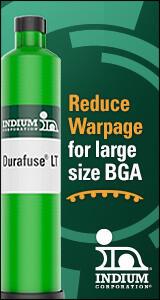|

|
|
| Ask the Experts | |||||||
|
|||||||
|
May 7, 2006 - Updated July 5, 2007 - Originally Posted Can I use my old oven for lead-free reflow?I have a Goldflow GF12A reflow oven that has 3 heating stages and one cooling stage. It is a ramp, hold and peak cycle. Is it possible to use this for non-leaded soldering? What potential issues should I be looking for in the process de-bugging. Ed Taylor |
|||||||
| Expert Panel Responses | |||||||
|
Additional information will be required to provide an answer to this question. Virtually any but not all existing reflow oven can reflow lead free solder. The issues to investigate and understand include: What is the thermal mass and thermal balance of the product(s) being reflowed? Can your oven create the reflow profile specified by the lead free solder paste you are using? What is the cycle time requirement for the products being reflowed (will you have to slow down the oven to achieve the required profile)? What is the maximum temperature raise tolerance, and cooling rate tolerance of the components being reflowed? What is the material of the printed circuit board being reflowed? Will you use a Nitrogen atmosphere for your reflow process (Nitrogen may or may not be required depending on your materials, components, etc.)? Using your existing oven for lead free materials may be possible but there is a great deal of investigation to be done. As one of the leading suppliers of reflow oven, we have customers who have been successful using their existing reflow ovens for lead free materials and we have seen other customers purchase new reflow ovens for their lead free process. Many of our high volume customers have purchased the newly designed large ten zone ovens to have as much flexibility as possible for their lead free process. Another factor to consider is the improved efficiency in the use of power and Nitrogen on the new reflow ovens. A high volume customer with a number of reflow ovens can achieve a significant savings in power and Nitrogen consumption with the improved efficiency of the new reflow ovens.
Principal Consultant ITM Consulting Mr. Belmonte has been a process engineer and process engineering manager in the electronic manufacturing industry for over 25 years, with experience in all aspects of electronic product assembly operations. He is well-known throughout Asia and SE Asia for both his process work and teaching engagements.
This will depend not just on your oven but also on your board. The key here is how effective and efficient is the heat transfer in the oven. You can help some what by reducing peak temperature but you will need to extend the time above liquidus to compensate and you can easily end up outside the recommended profile. I have not seen any data that say you can obtain a function joint with a peak of less 229-230oC for 10 seconds. The joint you get is unlikely to be esthetically pleasing but should be functional. If you require a respectable visual appearance then I would suggest that you look at 240oC. If your oven limit is 250oC then you are unlikely to achieve this. Typically to get 240oC you need a zone setting of 260- 280oC depending on the oven. It would be worth consulting your oven manufacturer to determine the capabilities of your specific model.
Senior Applications Chemist Henkel Electronics Dr. Poole is a Senior Applications Chemist in Henkel Technologies, electronics assembly materials application engineering group. He is responsible for all of Henkel's assembly products including soldering products, underfills, PCB protection materials, and thermally conductive adhesives.
There is a popular debate these days about the number of zones needed to successfully process lead free solder. Frankly, there is some science and an equal amount of salesmanship associated with this debate. There has been a lot of science applied to the Lead Free process and so much research that it is safe to say that the process is very well known and "nailed down". But the papers and research you will see and the papers you will read are done for a general audience and cover 95% of the applications out there. They are not done specifically for you. In other words, something that works for you might not work for others and vice versa. Bottom line: DATA RULES! The best way to know if your 3 zone machine will effectively process Lead Free is to run some profiles. Work with a paste vendor to find a suitable paste for your application and if the machine can meet the profile requirements, you're done! Since Lead Free has a smaller process window than Tin Lead you may find that 3 zones are not enough to meet the profile parameters. Therefore, more zones can help in terms of profile sculpting and meeting the tighter requirements of the process. But at the end of the day, it's all about meeting the process parameters of the profile and the paste. So if the 3 zone oven can give you the graph—take it! (and save the equipment expenditure).
President Heller Industries Inc. Mr. Peo has been with Heller Industries for over 20 years and has been President for the past 8 years. Marc has authored several industry articles on Soldering, Flux collection, nitrogen use and Lead Free conversion.
|
|||||||
| Submit A Comment | |||||||
|
Comments are reviewed prior to posting. You must include your full name to have your comments posted. We will not post your email address. |
|
Free Newsletter Subscription
Circuitnet is built for professionals who bear the responsibility of looking ahead, imagining the future, and preparing for it. Insert Your Email Address |
|

|




